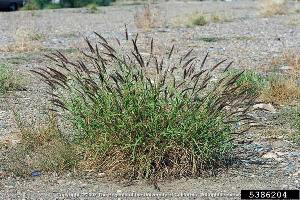Buffelgrass is a highly nutritious grass excellent for grazing in hot, dry areas. It also has the conflicted distinction of being a devastating threat to the native flora, fauna, and ecosystem patterns within the Sonoran, Chihuahuan, and Mojave deserts of the southwest United States, and in Hawaii.
Photo Credit: © Joseph M. DiTomaso, University of California - Davis, Bugwood.org.
Pennisetum ciliare
Common Name: buffelgrass
Other Scientific Names: Cenchrus ciliaris
Plant Functional Group: Graminoid
Class > Order > Family: Magnoliopsida > Poales > Poaceae
What does the species look like?
Buffelgrass is a tufted, erect to spreading, annual to perennial grass, growing 6 to 60 inches tall. Its tiny, green, inconspicuous flowers have both male and female parts and are wind-pollinated. The flowers are surrounded by bristles and are densely arranged along a spike.
Buffelgrass is a drought-tolerant species that is well adapted to deep, well-drained soils of many textures. It is commonly found in disturbed places, roadsides, and fields, but often occurs on wild, natural sites having sandy soils.
Where is the species found?
States & Provinces
AZ, CA, FL, HI, LA, MO, NM, NY, OK, PR, TX, VI
Special Considerations for Observing
If drought seems to be the cause of leaf withering for a plant, please make a comment to that effect.
Which phenophases should I observe?
Do you see...?
Leaves
Initial growth More...
Leaves More...
What percentage of the plant is green?
Less than 5% 5-24% 25-49% 50-74% 75-94% 95% or more
Flowers
Flower heads More...
How many fresh flower heads are present?
Less than 3 3 to 10 11 to 100 101 to 1,000 More than 1,000
Open flowers More...
What percentage of all fresh flowers (unopened plus open) on the plant are open?
Less than 5% 5-24% 25-49% 50-74% 75-94% 95% or more
Pollen release More...
How much pollen is released?
Little: Only a few grains are released. Some: Many grains are released. Lots: A layer of pollen covers your palm, or a cloud of pollen can be seen in the air when the wind blows
Fruits
Fruits Pennisetum ciliare , the fruit is a tiny grain, hidden within tiny bracts and grouped into small clusters that are closely arranged along a spiked plume (or seed head), that changes texture from soft or watery to hard and drops from the plant. Do not include seed heads that have already dropped all of their grains.More...
How many fruits are present?
Less than 3 3 to 10 11 to 100 101 to 1,000 More than 1,000
Ripe fruits Pennisetum ciliare , a fruit is considered ripe when it is hard when squeezed and difficult to divide with a fingernail, or when it readily drops from the plant when touched. Do not include seed heads that have already dropped all of their grains.More...
What percentage of all fruits (unripe plus ripe) on the plant are ripe?
Less than 5% 5-24% 25-49% 50-74% 75-94% 95% or more
Recent fruit or seed drop More...
How many mature fruits have dropped seeds or have completely dropped or been removed from the plant since your last visit?
Less than 3 3 to 10 11 to 100 101 to 1,000 More than 1,000
What do these phenophases look like?
There is currently no photoguide available for this species. If you'd like help us create one, use the guidance document and species template provided here . Then send it via email to education@usanpn.org when it is complete.
